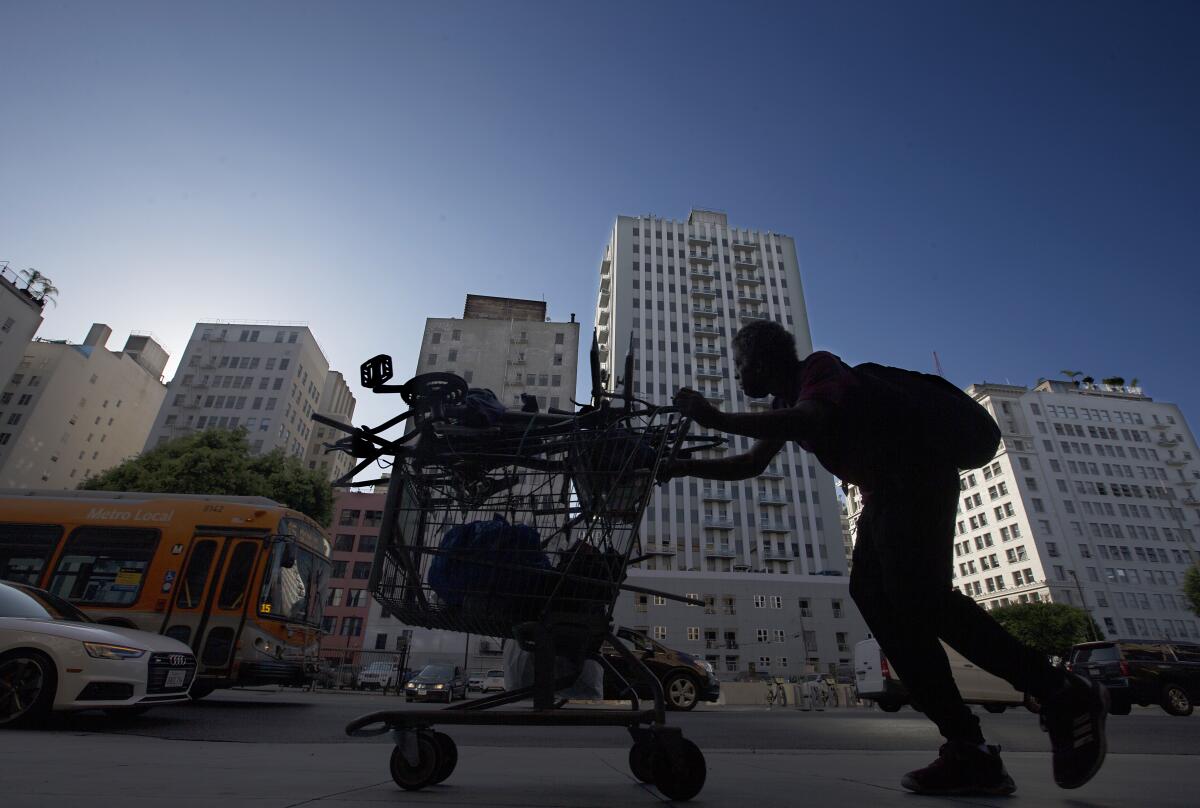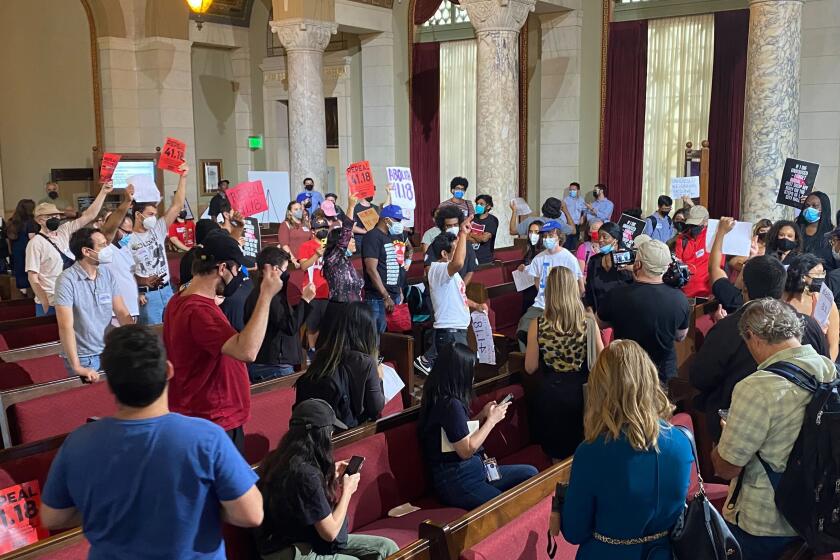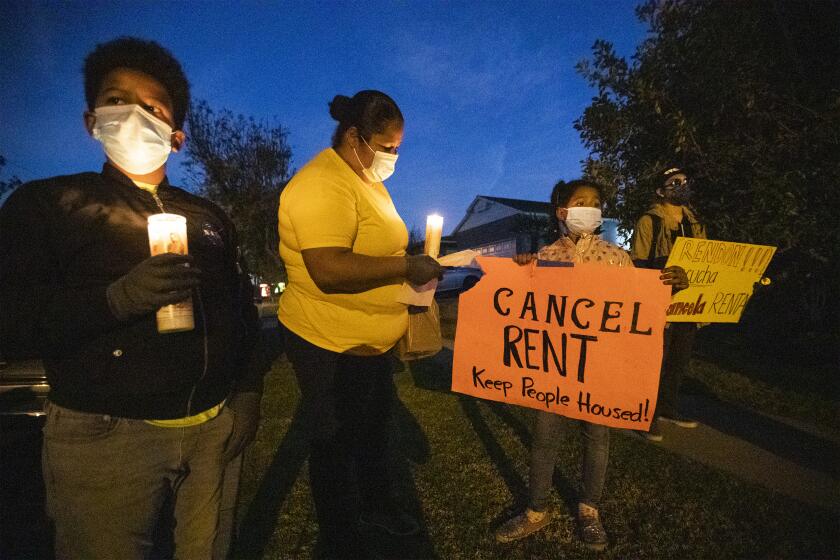Growth in L.A. County homeless population slowed during pandemic, count finds

- Share via
The growth of the homeless population in Los Angeles County slowed over the last two years in part because of policies brought on by the pandemic, according to results of the newly released homeless count.
The Los Angeles Homeless Services Authority, which coordinates the annual count for most of the county, found that the region’s homeless population grew by 4.1% from 66,436 in 2020 to 69,144 in 2022. The percentage of those individuals living indoors in shelters increased from 28% to 30%.
The city of Los Angeles saw its homeless population grow by 1.7% from 41,290 to 41,980 for the same time period.
The results made public by the Los Angeles Homeless Services Authority on Thursday are in contrast to previous years when the region’s homeless population had exploded in size, growing by 25% between 2018 and 2020.
The findings —which are a statistical estimation — come at a crucial time in a region where homelessness and housing affordability have become pressing issues particularly in Los Angeles, where voters will soon elect a new mayor.
Los Angeles Homeless Services Authority officials attributed the decelerating growth of the homeless population to policies enacted during the pandemic, such as the federal and state unemployment relief, rent and eviction moratoriums, utility assistance programs and boosting the region’s shelter capacity.
“It is encouraging to learn that our efforts to confront this crisis have not been in vain,” Mayor Eric Garcetti said. “And I know that if we keep doubling down on the historic investments we’ve made, working together, and continue to treat every person living on our streets with compassion and humanity, we will become a more resilient, fair and just city.”
The results received mixed reactions from politicians and advocates for homeless people. Some said they were cautiously optimistic about the progress while others were disappointed that there wasn’t more, given the billions of dollars that have been invested to tackle the crisis. Many worry about the challenges that lie ahead.
“We are in a precarious moment,” Molly Rysman, LAHSA’s acting co-executive director said in a briefing with reporters before the numbers were released. “Many of the policies and investments that prevented COVID from driving more households into homelessness have or will end soon, we need to learn from these policies and investments and make them ongoing.”
The new restrictions dramatically expand the number of locations in L.A. where sleeping and camping are off-limits.
David Smith, director of litigation with the Inner City Law Center, a nonprofit poverty-law firm based in skid row, echoed that sentiment and said the numbers underscore the need for elected officials to keep in place the moratoriums that prevent landlords from evicting tenants or increasing rents on rent control units.
“They definitely have helped,” Smith said. “But they’re Band-Aids at best and they’re coming off soon and I think there’s definitely a need for these type of protections to be made permanent in some fashion to prevent an avalanche of evictions.”
Smith said he’s already seeing a high number of eviction cases despite the protections, with landlords often hoping uninformed tenants will not challenge them in court. He said city officials also need to address slumlords who allow buildings to deteriorate as a way to push out rent control tenants for market rate tenants.
“There’s a lot of different factors at play and a lot of different headwinds to deal with so I hope people don’t take any kind of comfort in any downward trend from these numbers.”
The changes were not spread evenly across the county. The largest increases were in the harbor area (18%) and South L.A. (12%) while a 23% decrease was recorded in the Westside. The L.A. metro area, where the most homeless people were found, had a 4% increase to just under 18,000.
The numbers also show the racial inequity of homelessness in the county. Black people continue to be disproportionately represented while white and Latino people have slightly trailed below the represented population.
LAHSA officials said the number of homeless veterans shrank but there were increases in other subgroups including women and seniors.
The results of the count will be essential in determining how much new interim housing the city must build to satisfy an agreement announced this spring with plaintiffs of a federal lawsuit concerning homelessness.
As part of that settlement, the city pledged to create housing, either permanent or interim, for 60% of the city’s unsheltered homeless population. A city official estimates Los Angeles will need to have about 13,000 beds to meet this obligation. The city plans to issue a report in the next month that lays out how much housing each council district must have to adhere to the settlement.
Until now, it was not known what impact the pandemic had on the county’s homeless crisis. There were concerns that the economic downturn caused by the coronavirus would exacerbate the problem by sending a new wave of people into homelessness.
Cheri Todoroff, executive director of the Los Angeles County Homeless Initiative, saw the leveling trend as the effect of the tenant protections adopted during the pandemic that helped vulnerable people keep their housing.
“That’s ultimately how we are going to change the face of homelessness in our county. If we could stop the inflow into homelessness,” said Todoroff, who heads the county office that guides the use of the Measure H homelessness sales tax revenue.
Those gains could be at risk as pandemic-related protections are lifted, she said.
Some of the nation’s strongest protections against eviction and rent increases could end in January after city housing officials recommended their expiration.
LAHSA officials said the response to the pandemic helped increase shelter capacity in the county by 62% from 15,617 beds in 2019 to 25,263 in 2022.
Still, officials said more needs to be done. The county needs to continue addressing policies that have contributed to the region’s homeless crisis, including lack of affordable housing and inadequate support for people exiting jails, prisons and foster care. The Greater Los Angeles area will also need about 800,000 units of housing over eight years to keep people from becoming homeless.
Although Los Angeles Homeless Services Authority officials said the pandemic made it difficult to count youth and family homeless populations — about 10% of the homeless count —they say in the short term the numbers point to a possible flattening of the curve.
The “point in time” homeless count initially takes place in January but this year it took place in February due to a winter surge caused by the Omicron variant of the coronavirus. Volunteers spread out over the county over several nights to document the visible signs of homelessness. The survey helps the county determine where to distribute resources to unhoused people and allocate millions in state and federal funding.
The last count conducted was in 2020, before the pandemic forced LAHSA officials to cancel last year’s count.
The slowing rate of increase was a relief for those who were bracing for much worse.
“No one wants to see homeless numbers increase even a by a single percentage point, but considering what we’ve been through, today’s announcement makes clear that we averted a great disaster,” said L.A. County Supervisor Sheila Kuehl. “Instead, because of intentional and impactful local investments, as well as significant investments from the state and the federal government, we were able to be flexible and innovate, significantly expanding our shelter and permanent housing capacity.”
Anticipation of a larger increase may have been fueled by a phenomenon that showed up in the demographic survey accompanying this year’s count: tents, makeshift shelters and vehicles increased more than the people living in them.
The count documented a 17% increase in the number of those shelters. The follow-up demographic survey of thousands of homeless people found that fewer people were living in each one.
“So how do we explain this?” asked Kristina Dixon, acting co-executive director of the Los Angeles Homeless Services Authority in the briefing.
A major cause was the restriction on cleanups following the Centers for Disease Control and Prevention guidance on not disturbing encampments during the pandemic.
“Without the cleanups, the number of tents increased,” Dixon said. “Meanwhile, our shelter options increased, as did our effort to bring people into them. As a result, more people moved inside and some left tents behind.”
Dixon said more than 21,000 people had been housed, continuing a trend that has seen 86,000 people brought indoors since 2018.
“If the greater L.A. area could stop people from falling into homelessness, we could end homelessness in three to four years,” she said.
Times staff writer Benjamin Oreskes contributed to this report.
More to Read
Sign up for Essential California
The most important California stories and recommendations in your inbox every morning.
You may occasionally receive promotional content from the Los Angeles Times.














